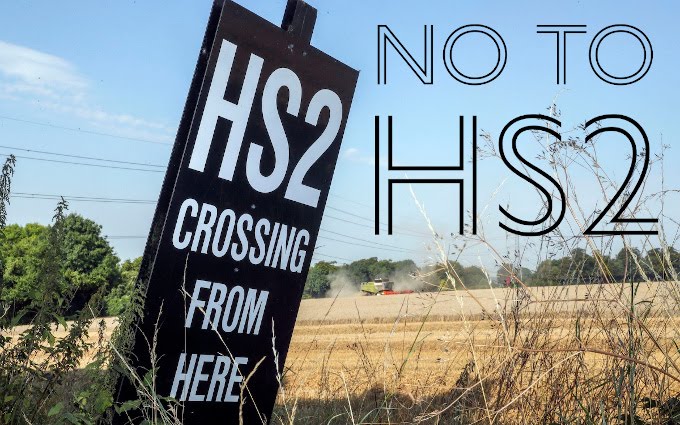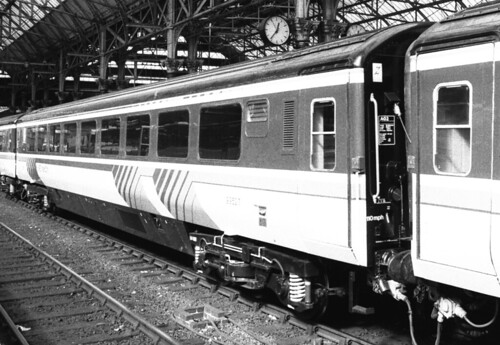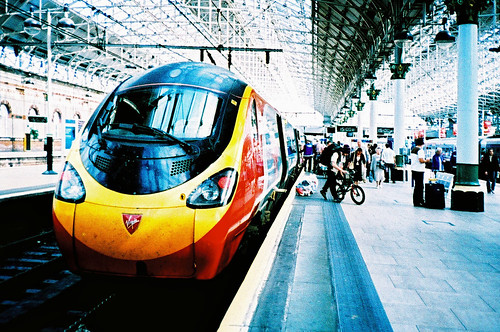30 Nov 2010
What rolling stock?
One of the great unanswered questions concerning HS2 is what kind of rolling stock will run on it? British rolling stock is lower and narrower than standard continental stock. And standard continental stock is too tall and wide to run on existing railways in Britain. Will there be a small fleet of continental-sized stock that will be confined to the new lines? And will it be necessary to build a special, and therefore expensive, fleet of British-sized high speed trains that can run on existing routes?
This raises yet another question. Continental stock actually varies in size from one country to another. Scandinavian trains are wider than those anywhere else, which makes for added comfort, or alternatively, more seats can be fitted into the carriages. And would also be possible to build the line large enough to accommodate double-deck trains that did not have low curved ceilings like those in most of Europe apart from Finland, where the gauge is slightly wider. (1525 mm instead of 1435 mm). I cannot find any discussion of this issue.
This raises yet another question. Continental stock actually varies in size from one country to another. Scandinavian trains are wider than those anywhere else, which makes for added comfort, or alternatively, more seats can be fitted into the carriages. And would also be possible to build the line large enough to accommodate double-deck trains that did not have low curved ceilings like those in most of Europe apart from Finland, where the gauge is slightly wider. (1525 mm instead of 1435 mm). I cannot find any discussion of this issue.
Project gathers momentum
As the project gathers momentum, it will become increasingly unstoppable. That a good case has been made to show that the economics of the project are based on dubious assumptions seems to cut no ice with the politicians.
The HS2 Action Alliance
The principal focus for opposition to HS2 is the HS2 Action Alliance (see link on right). Naturally, the opposition has arisen amongst those who stand to be worst affected, which is people in the areas of the Chilterns through which the line passes. However, having a vested interest in something does not invalidate an argument. The more the economic case is considered, the worse it seems. One wonders why HS2 has survived the cuts.
Selective door operation
An effective standard system of Selective Door Operation (SDO) must be one of the keys to increasing capacity on the railways. The lengthening of station platforms to accommodate longer trains can be prohibitively expensive at some locations and is unnecessary at others.
The solution is to fit every door on every train with a detector linked in to the door-actuating circuit, to prevent it from being opened unless there is a station platform alongside. It might take the form of a light and photocell on the train, with the face of the platform being fitted with a strip of reflective material like that on car number plates. Or it could use some kind of sonic or infra-red device - the principle is the same. In the long run this would be a good investment as all trains could stop at all stations. It would be fail-safe, automatic and do away with the complexities of GPS location finding, which requires the train to "know" where it is.
The solution is to fit every door on every train with a detector linked in to the door-actuating circuit, to prevent it from being opened unless there is a station platform alongside. It might take the form of a light and photocell on the train, with the face of the platform being fitted with a strip of reflective material like that on car number plates. Or it could use some kind of sonic or infra-red device - the principle is the same. In the long run this would be a good investment as all trains could stop at all stations. It would be fail-safe, automatic and do away with the complexities of GPS location finding, which requires the train to "know" where it is.
Alternatives to HS2 - official
Last year, the Department for Transport commissioned consultants W S Atkins to consider alternatives to HS2. Referred to as the High Speed 2 Strategic Alternatives Study, it comprises four separate reports. It looks at a range of road and rail interventions between London and the West Midlands, which could effectively increase passenger capacity in line with forecast demand. The documents are available for downloading here.
The Rail Interventions Report concentrates on upgrades to the West Coast Main Line and the Chilterns route to Birmingham and in case of the latter, an interesting list of interventions are postulated. Amongst the options discussed is the possibility of running much longer trains on the WCML. But this is dismissed in the following sentence:
"However, operating a fleet of 400 metre would require platforms at every station served by WCML “fast” services to be lengthened. Selective Door Opening (“SDO”) is unlikely to prove acceptable or workable."
This curt dismissal of a major policy option is strange because what is called for is better SDO systm. Probably this would incorporate a detector system linked into the door opening mechanism. Such a device could be fitted to every door on the train, to ensure that the door could not be opened unless there was a platform alongside. Obviously it would take quite a lot of development work but calls for nothing that existing technology could not solve.
The report dealing with rail interventions mentions in passing that "HS2 Ltd have been tasked by DfT to test the cost and capacity of an entirely new conventional route between London – West Midlands ." I would like to get a look at that report.
The Rail Interventions Report concentrates on upgrades to the West Coast Main Line and the Chilterns route to Birmingham and in case of the latter, an interesting list of interventions are postulated. Amongst the options discussed is the possibility of running much longer trains on the WCML. But this is dismissed in the following sentence:
"However, operating a fleet of 400 metre would require platforms at every station served by WCML “fast” services to be lengthened. Selective Door Opening (“SDO”) is unlikely to prove acceptable or workable."
This curt dismissal of a major policy option is strange because what is called for is better SDO systm. Probably this would incorporate a detector system linked into the door opening mechanism. Such a device could be fitted to every door on the train, to ensure that the door could not be opened unless there was a platform alongside. Obviously it would take quite a lot of development work but calls for nothing that existing technology could not solve.
The report dealing with rail interventions mentions in passing that "HS2 Ltd have been tasked by DfT to test the cost and capacity of an entirely new conventional route between London – West Midlands ." I would like to get a look at that report.
29 Nov 2010
External costs of road use
I came across this in the Guardian's Comments is Free
The annual external costs of road use in the UK have been estimated as follows...- Air pollution £19.7 bn
- Congestion £17.5 bn
- Accidents £9.4 bn
- Noise £2.6 bn
- Road damage £1.5 bn
- Climate change 0.1 bn
- (Road building not included)
- Total £50.8 bn.
Thus motorists are being subsidised by an amount three times larger than the taxes and duty they pay.
http://www.basden.demon.co.uk/G/facts/road.costs.html
The fate of the BREL International train
This experimental train built in 1986 was one of the more attractive products of British Rail Engineering Ltd. It was eventually sold to the Irish railways and re-gauged.
Most of the vehicles were scrapped in 2009. A couple were brought back to the UK and used for bombing practice. Nice to know that a proper value was put on these assets.
22 Nov 2010
The BT10 bogie

An unsung design classic
The BT10 bogie is fitted to mark 3 Inter City stock, including the HST trailer cars. Introduced in the mid-1970s, some units have now been in service for 35 years. These were amongst the first to be fitted with disc brakes and for several years there were complaints about the smell. But once this had been cured, they proved to be exceptional, giving a smooth and steady ride at high speed on indifferent track. Recent tests have shown them to be superior to more recent designs, as well as being significantly easier on the track.
I was discussing this with a colleague recently who has been involved recently in the maintenance of vehicles fitted with these bogies. Apart from a few minor details, he told me that there are no fundamental weaknesses in the design - such as areas prone to fatigue - and after three decades in service they would have shown up by now.
The elegant simplicity of the concept is revealed in the diagram.
17 Nov 2010
Pendolino Britannica
10 Nov 2010
What a horrible design

F SNCF 72571 Manosque 31-07-2009 , originally uploaded by peters452002.
This really looks a mess. The trouble is that there are two different aesthetics in conflict with each other. Or has the cover fallen off the gubbins? If it hasn't, then it is pointless giving the train a sexy front end.
These trains below, with simple, functional front ends, have exactly the same coupling so there is no necessity for the thing to look so awful.
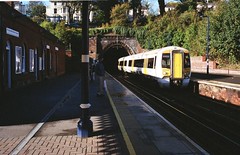
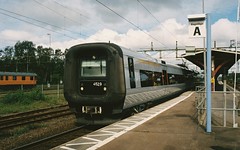
9 Nov 2010
Rail operators must pay for new carriages - report
Rail operators will have to rely less on subsidies to increase train capacity and the transport department should require new operators to provide enough carriages for passengers, a report by the British Public Accounts Committee said on yesterday.
The problem is a combination of a shortage of carriages, poor seating capacity in the carriages themselves, and short platforms in some stations, which prevents the running of longer trains.
The troubles go back a long way. One of them is that the rolling stock itself is too expensive. A mark 1 coach cost about £5000 in the 1950s. That is about £200,000 in present-day money. But a new hauled vehicle cannot now be purchased for less than £600,000, and self-powered electric or diesel multiple unit (EMU/DMU) vehicles cost at least twice that amount. And in the 1950s - and right up to the late 1980s, EMUs were usually powered with recycled the electrical equipment which was very robust and was often decades old already. Such recycling is unheard-of today.
Of course in the 1950s, train speeds were much lower and modern equipment is more energy-efficient, and there are safety issues as well, all of which have driven up the cost. Air conditioning has come to be expected as a standard fitment, and toilets that discharge onto the track are considered unacceptable.
Nevertheless, there has been waste on a gigantic scale. For example, the electrical equipment and many other components in the 1300 or so mark 1 EMU fleet could have been recycled into new vehicles, as the same equipment continues to give good service on a substantial proportion of the fleet and is likely to remain in use for another 20 years or so. Indeed, the mark 1 fleet itself, despite its age, was perfectly acceptable for use on secondary routes and superior to the slightly newer stock now running on those lines.
The spread of fixed-formation trains also contributes to the shortage, as it is not possible to add extra vehicles kept on standby.
Where do we go from here? There is a need
The problem is a combination of a shortage of carriages, poor seating capacity in the carriages themselves, and short platforms in some stations, which prevents the running of longer trains.
The troubles go back a long way. One of them is that the rolling stock itself is too expensive. A mark 1 coach cost about £5000 in the 1950s. That is about £200,000 in present-day money. But a new hauled vehicle cannot now be purchased for less than £600,000, and self-powered electric or diesel multiple unit (EMU/DMU) vehicles cost at least twice that amount. And in the 1950s - and right up to the late 1980s, EMUs were usually powered with recycled the electrical equipment which was very robust and was often decades old already. Such recycling is unheard-of today.
Of course in the 1950s, train speeds were much lower and modern equipment is more energy-efficient, and there are safety issues as well, all of which have driven up the cost. Air conditioning has come to be expected as a standard fitment, and toilets that discharge onto the track are considered unacceptable.
Nevertheless, there has been waste on a gigantic scale. For example, the electrical equipment and many other components in the 1300 or so mark 1 EMU fleet could have been recycled into new vehicles, as the same equipment continues to give good service on a substantial proportion of the fleet and is likely to remain in use for another 20 years or so. Indeed, the mark 1 fleet itself, despite its age, was perfectly acceptable for use on secondary routes and superior to the slightly newer stock now running on those lines.
The spread of fixed-formation trains also contributes to the shortage, as it is not possible to add extra vehicles kept on standby.
Where do we go from here? There is a need
- to shift to locomotive-haulage, which is more economic when trains are five cars long or more and allows vehicles to be added or removed in response to demand.
- for vehicles which can have a variety of seating layouts without compromising comfort unduly - which rules out the customary 1:3/2:3 door configuration.
- an effective platform-detection system which can be fitted to all stock, so that long trains can stop as stations with short platforms without the risk that passengers will step off into oblivion.
- to evaluate the systems fitted to vehicles on a value-for-money basis. This applies to features such as air-conditioning, fault-detection systems, at-seat power supplies, and all the other expensive things that fall into the category of nice-to-have.
- to establish what are the optimum trains speeds on a value-for-money basis.
8 Nov 2010
Missed tram - missed opportunity
This mini-tram was on trial in Brighton in 1994. An example of the Parry Peoplemover, it came to nothing and the streets are still choked with cars.
Subscribe to:
Posts (Atom)
